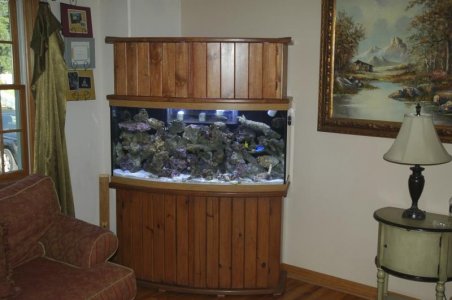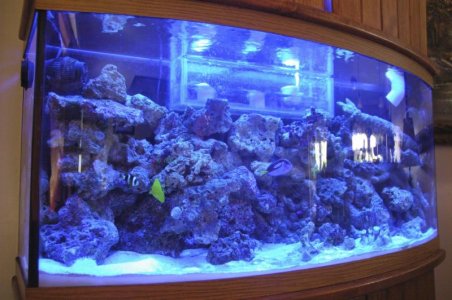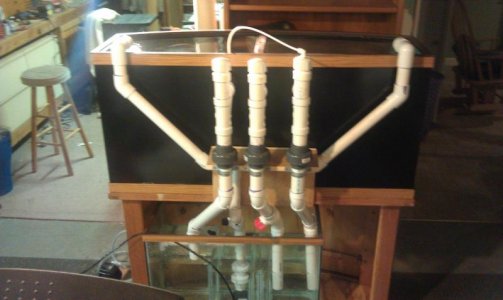Will make the siphon pipes 1.5" and throttle at the sump end; planning to use flexible PVC for the complete runs.
The 2" open channel will be flexible PVC with union ends and have a connection to a long sweep 3" PVC at the bottom of the vertical (running 3" PVC horizontally with a 1/4" per foot slope to the sump).
Opinions or Comments: For the multiple closed loop set up (five closed loops: (i) 3 at 3,000 gph/loop across the bottom; (ii) 4x1.5" Ocean Motions (OM-4way) at 1,800 gph; and (iii) Detritus under rock at 1,800 gph) for a total approximately 12,600 gph maximum. Was thinking of utilizing a main supply manifold for the closed loop system where four 2" bulkhead discharges are drawn from (or through) the rear wall of the tank (bottom inverts to be approximately 12" from of the glass floor or 8" above the sand with a "Y" split and screens on each. The intent or objective would be to draw the water flow through the rock towards the back of the tank and downward to assist in the barrel rolling effect within the tank. Alternatively, possibly (2) 3" bulkhead penetrations in the bottom of the tank, again split hidden with the rock scape.
The manifold in the crawl space below (about 7') where the pumps shall be located. An alternative would be to have
Returning: drawing off the manifold will be the five (with possible expansion for an additional loop or two) to the closed loop pumps. Each pump would have an inline check valve. The 3 main returns distributed through 3 bulkhead fittings in the bottom of the tank and piping submerged in the 4.5" of sand. The (4) - 1.5" for the OM four-way and the detritus loop shall be through bulkhead fittings staggered across the back of the tank's rear wall between 8" and 10" from the bottom. All of these returns shall have "y" splits and flexible Loc-Line equipped with Eductors for adaptability and changing/toying with the dynamic flow within the tank. I am hoping to find computer controlled/programable variable flow pumps (DC if possible) to be used on every loop (still searching).
There are several objectives system for flow within the tank of the intended concept:
1) Create a "barrel roll" effect in the tank to cause the surface water back towards the coast to coast overflow box at the rear.
2) minimize dead spots or areas in the tack and corners
3) maximize flexibility for future changes
4) Develop an intergrated system combining the fixed piping, two Vortech MP60s and an Oceans Motions 4-way (primarily used for creating changing dynamics within the rock scape); these coupled with programable variable flow pumps to generate 25,000 to 35,000 gph of flow for SPS reef aquascape.
To help understand, three more illustrative CAD drawings have been uploaded:
(a) one plan view with piping layout (without the proposed rock scape)
(b) one plan view and piping layout with the proposed rock scape
(c) a cross section indicating the locations of returns and showing the "barrel role" concept.
Link:
http://www.projectmorpheus.me/CreatureMorpheus/600g_Tank_Flow_&_Piping.html#grid



